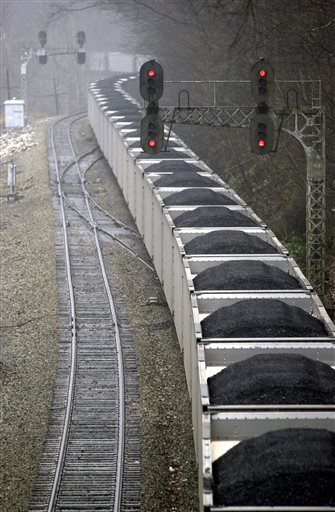Coal decline: It’s the shale gas, West Virginia
October 11, 2016 by Ken Ward Jr.
A CSX train loaded with coal winds its way into the mountains in this photo taken near the New River at Cotton Hill in Fayette County, W.Va. (AP Photo/Jeff Gentner)
There’s an important new study out that goes to the heart of the political discussion in West Virginia about the coal industry’s decline. Here’s the press release from the authors at Case Western University:
Cheap shale gas produced by fracking has driven the decline in coal production in the United States during the last decade, researchers at the Great Lakes Energy Institute at Case Western Reserve University have found.
Power plants, which use 93 percent of the coal produced nationally, have been operating under the same EPA regulations signed into law by President George H.W. Bush in 1990. Proposed new rules since then have all been challenged in court and not implemented until June 2016, when the EPA’s restrictions on mercury and other toxic emissions were approved by the U.S. Supreme Court.
Consumption of coal continued to grow under those 1990-era EPA rules until 2008, and then went into steady decline, dropping by 23 percent from 2008 thru 2015.
The data show the drop in those years to be correlated with the shale revolution, as natural gas production increased by a factor of more than 10 and its price dropped in half, the researchers say. And, due to the continuing–and in some cases accelerating–technological and economic advantages of gas over coal, the decline in coal is expected to continue at least decades into the future.
Mingguo Hong, associate professor of electrical engineering and computer science at Case Western Reserve and co-author of the study, said:
Some people attribute the decline in coal-generated electricity to the EPA’s air-quality rules, even calling it ‘Obama’s war on coal . While we can’t say that the EPA rules have no impact — as, for example, discouraging the building of new coal power plants because of the expectation that tougher air-quality rules will clear the courts — the data say the EPA rules have not been the driving force.
Hong and co-author Walter Culver, a founding member of the Great Lakes Energy Institute Advisory Board at the university, say the data show that shale-gas competition is what’s been hurting coal as of today. They expect that, as wind and solar sources of electricity continue to improve, they will be tough competitors to coal in the not-distant future. According to Culver:
If you’re a power plant operator and you see gas supply is continuing to increase and natural gas can do the job cheaper–by a lot–the decision to switch from coal is pretty easy. As we look toward the future, we see no natural mechanisms that will permit coal to recover.

 Subscribe to the Coal Tattoo
Subscribe to the Coal Tattoo
